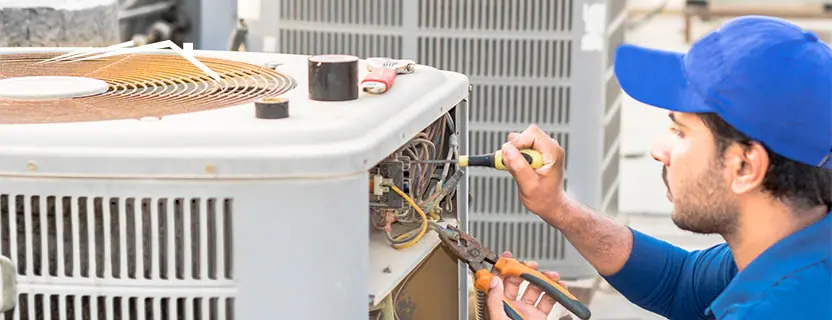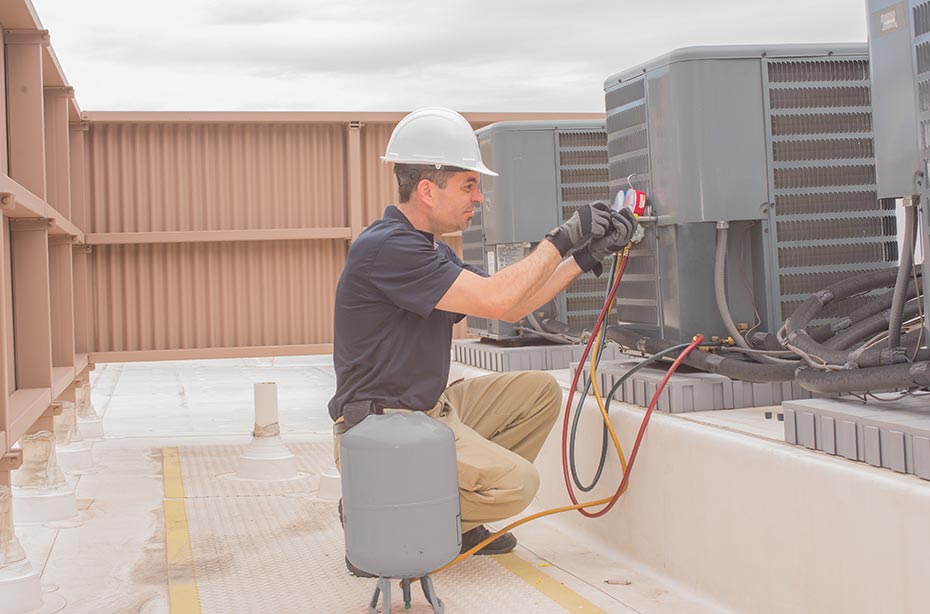Exactly How a Heatpump and Heater Interact to Optimize Your Home's Heating Performance
Comprehending just how a warmth pump and heater job with each other is vital for house owners looking for effective home heating services. Each system has its toughness, giving a well balanced strategy to home comfort. The heatpump stands out in modest temperatures, while the heating system supplies rapid heat during severe cold. This harmony not just minimizes energy prices however likewise improves the lifespan of both devices. What variables affect this collaboration, and how can property owners optimize their advantages?
Understanding Warm Pumps: How They Work
Numerous people might be unknown with their inner functions, heat pumps play a crucial duty in modern home heating systems. These tools operate by moving warm from one place to an additional, using the concepts of thermodynamics. In cooler months, a heat pump extracts heat from the outside air, ground, or water, and transfers it inside to warm up the space. Alternatively, during warmer months, it can turn around the procedure, acting as an a/c by removing warmth from inside to the outside.Heat pumps include an evaporator, growth, condenser, and compressor shutoff. The cooling agent within the system takes in warm as it vaporizes at reduced temperature levels and pressures. The compressor after that enhances the pressure and temperature of the cooling agent, allowing it to release heat as it condenses. This effective process can significantly decrease power consumption compared to typical heating techniques, making warmth pumps a sustainable choice for environment control in homes.
The Duty of Heaters in Home Home Heating
Heating systems play an essential role in home heating by offering a trustworthy resource of heat throughout the chillier months. They run by generating heat via combustion or electrical resistance, dispersing it throughout the home using ducts or radiant systems. The effectiveness of a heater is typically determined by its Annual Fuel Utilization Efficiency (AFUE) rating, which indicates exactly how efficiently the device transforms fuel into heat.Furnaces can make use of various power resources, including gas, electricity, oil, or lp, allowing property owners to select the most appropriate option for their requirements. Unlike heatpump, which might battle in severe chilly, furnaces maintain consistent performance, making certain that indoor temperature levels remain comfy no matter outside conditions. Additionally, modern furnaces frequently come equipped with advanced modern technology, such as variable-speed blowers and wise thermostats, enhancing their performance and responsiveness. This convenience makes furnaces a crucial part in comprehensive home heating strategies.

Advantages of Utilizing Both Systems Together
Incorporating the staminas of both furnaces and heatpump can bring about a more reliable and reliable home heating service. Utilizing both systems enables homeowners to benefit from the heatpump's power performance during milder temperature levels while depending on the heating system for even more extreme cold problems. This twin strategy can considerably lower power expenses, as heat pumps consume less electricity than standard home heating techniques when temperatures are moderate.Additionally, using both systems with each other can improve convenience degrees in the home. Heatpump can offer constant, also heating, while heaters can swiftly increase ambient temperature levels when needed. The assimilation of both systems can prolong the life-span of devices by decreasing wear and tear on each system, as they share the work. Ultimately, home owners can enjoy a balanced, economical heating solution that readjusts flawlessly to varying weather, making sure a warm and inviting home throughout the winter season.
Just How Warm Pumps and Furnaces Complement Each Other
When homeowners incorporate heat pumps and furnaces, they create a corresponding heating unit that optimizes performance and comfort. Warm pumps run by moving heat from the outdoors air or ground, making them highly effective in modest environments. They stand out during milder temperature levels, providing affordable home heating. Conversely, furnaces generate heat with combustion or electrical resistance, providing solid, instant heat throughout severe chilly conditions.The combination of these two systems enables for vibrant adjustments based upon temperature level changes. Throughout warmer months or milder winter season days, the heatpump can take the lead, saving power and reducing expenses. As temperatures decrease, the heating system can flawlessly involve, guaranteeing constant heat throughout the home. This harmony not only maximizes energy use however also boosts the life-span of both systems, as each device runs within its excellent performance array. With each other, they develop a balanced environment that adapts to varying climate demands.
Optimizing Effectiveness: Tips for Homeowners
Home owners can improve their heating performance via numerous sensible approaches. Developing a normal maintenance schedule, integrating smart thermostat technology, and executing reliable insulation and securing solutions are key steps. These steps not only boost convenience however also lower energy prices.
Routine Maintenance Set Up
To ensure optimal heating performance, developing a routine upkeep schedule is important for any type of home. Homeowners must focus on routine inspections of both heatpump and heaters to ascertain peak performance. This includes changing air filters every one to three months, as blocked filters can significantly minimize performance. In addition, organizing specialist maintenance at the very least when a year permits service technicians to identify and address potential concerns before they escalate. Homeowners should additionally cleanse the heatpump's exterior device to avoid debris build-up that can hinder air flow. By sticking to a routine upkeep timetable, homeowners not only enhance their heating systems' effectiveness however likewise prolong their lifespan, leading to higher convenience and lowered energy prices throughout the cooler months.
Smart Thermostat Combination
Integrating a smart thermostat right into a home heating unit can substantially enhance power performance, especially as it permits accurate control over temperature settings. These tools can discover the house owner's routine and choices, immediately adjusting the temperature level to optimize convenience while minimizing energy usage. go to my site For example, they can decrease heating throughout times when the home is vacant, reducing unnecessary usage. Several wise thermostats likewise offer real-time power use information, making it possible for house owners to make informed choices about their home heating practices. Furthermore, remote access via mobile phone apps enables customers to readjust setups from anywhere, ensuring the home is warm upon return. Overall, smart thermostat assimilation not just improves comfort however substantially adds to energy cost savings and effectiveness.
Insulation and Sealing Solutions
Smart thermostats play a vital function in energy effectiveness, yet their efficiency can be substantially boosted by proper insulation and securing services. Homeowners must prioritize insulating wall surfaces, attics, and floorings to lessen heat loss. High-grade insulation products, such as spray foam or fiberglass, can substantially boost thermal resistance. In addition, securing gaps around ducts, home windows, and doors stops cold air infiltration and warm retreat. Weatherstripping and caulking work approaches for addressing these leaks - furnace replacement. Routine evaluations for air leaks, together with the use of blower door tests, can assist identify problem areas. By investing in insulation and securing, home owners can enhance the efficiency of their heating unit, inevitably resulting in decreased power usage and lower utility expenses
Common Misconceptions Concerning Heat Pumps and Furnaces
What misconceptions surround heatpump and heaters? Several people erroneously think that warmth pumps are inefficient in chillier environments. In reality, modern heatpump are designed to run successfully even in low temperatures, offering trustworthy home heating throughout wintertime. Another usual myth is that heaters are always extra effective than heat pumps. This depends on the details energy sources and efficiency ratings of the units in concern. Some may also think that using both systems all at once is unnecessary, however as a matter of fact, this mix can enhance home heating effectiveness, specifically during extreme climate conditions. Additionally, people commonly assume that warmth pumps need continuous upkeep, when in reality, they have similar upkeep requires to conventional heating systems. By debunking these myths, house owners can make more enlightened decisions regarding their heating alternatives, inevitably bring about enhanced comfort and energy effectiveness in their homes.
Upkeep Considerations for Combined Systems

Frequently Asked Concerns
Can Warm Pumps Work Effectively in Very Cold Climates?
Heat pumps can struggle in extremely cold climates because of reduced performance and warmth extraction constraints. Innovations in modern technology have led to models made for better performance in such problems, boosting their viability in rough environments.
For How Long Do Warm Pumps and Furnaces Commonly Last?
Heatpump normally visit their website last 15 to twenty years, while furnaces have a life expectancy of 15 to thirty years. Normal maintenance can expand their long life, guaranteeing effective procedure and lowering the demand for premature replacements.

What Is the Typical Cost of Installing Both Equipments?
The typical expense of setting up both a warmth pump and a heater normally varies in between $5,000 to $10,000 - furnace replacement. Variables influencing this cost consist of system size, installment intricacy, and regional labor rates
Exist Tax Obligation Rewards for Using Energy-Efficient Home Heating Systems?
Many house owners ask about tax rewards for energy-efficient home heating systems. Numerous government and state programs often offer credit ratings or rebates, motivating the adoption of lasting innovations to minimize power consumption and advertise environmental obligation.
Just how Do I Choose the Right Size Heatpump and Furnace?
Picking the right size warmth pump and furnace involves computing the home's square footage, thinking about insulation quality, and evaluating neighborhood climate. Consulting a professional can ensure excellent system performance and energy performance based on particular requirements. ductless mini splits. Comprehending how a warm pump and heater job with each other is crucial for home owners looking for reliable home heating remedies. In colder months, a warm pump removes heat from the outdoors air, ground, or water, and transfers it indoors to heat the living space. When home owners incorporate warmth pumps and furnaces, they create a complementary heating system that takes full advantage of performance and convenience. Warm pumps run by moving heat from the outside air or ground, making them very effective in moderate climates. Warmth pumps can have a hard time in exceptionally chilly climates due to reduced performance and warm extraction constraints